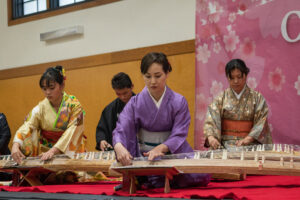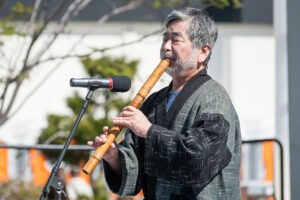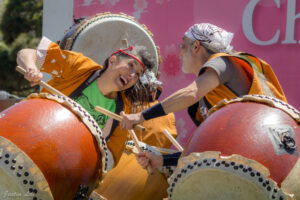The Festival features many facets of traditional and contemporary Japanese music culture. Our performing artists sing and play live music with Japanese instruments including the harp (Koto), flute (Shakuhachi), three-stringed instrument (Shamisen/Sangen), and drum (Taiko). Experience and feel the passion of each of the talented artists as they perform for the audience at the Japantown Peace Plaza Stage and the Japanese Cultural and Community Center of Northern California (JCCCNC/the Center) Stage!
Koto ç´
The koto, or Japanese harp, commonly has 13 strings and is traditionally made from a lightweight and strong paulownia wood. It is played by plucking the strings to produce a resonant sound. Originally an instrument of the Imperial Court, the koto is the national instrument of Japan and has long been a symbol of elegance and tradition. Today, many artists are experimenting with new genres of music like jazz and pop. Listen to the variety of styles new and traditional, brought to you by talented schools and performing groups.

Shamisen 三味線 / Sangen 三絃
The shamisen is a three-stringed traditional Japanese musical instrument derived from the Chinese instrument, Sanxian. The players press on the strings on the long neck and hold a large wooden plectrum, bachi, to pluck the strings over the square body to produce beautiful harmonies. The shamisen varies in shape depending on the genre. The square body is covered with skin in the manner of a banjo and amplifies the sound of the strings. The shamisen became a popular instrument in the entertainment districts of Japanese cities during the Edo period (17th century). Today, the shamisen is played for contemporary music and traditional settings like Kabuki and minyo performances. The shamisen is called the sangen when it accompanies Japanese folk music or the koto.

Shakuhachi 尺八
The Japanese flute, shakuhachi, was originally introduced from China to Japan in the 8th century and underwent a resurgence in the early Edo Period. The shakuhachi is traditionally made of bamboo, and the name comes from its length of shaku (one) and hachi (eight) sun (Japanese measuring unit), approximately 21.4 inches or 54.5 centimeters. You will now find shakuhachi also made with ABS plastic and hardwoods. It was originally used by the monks of the Fuke School of Zen Buddhism in the practice of suizen or “Blowing Zen” meditation.

Taiko 太鼓
The easily recognizable heartbeat of any Japanese festival, the sacred taiko drum is said to have been introduced to Japan from China in the fifth and sixth centuries. The powerful drumming was historically used in warfare, in religious ceremonies, in Noh and Kabuki theater, and is now popularly used in celebrations by thousands of taiko groups worldwide. Each year, a variety of dynamic groups play throughout the Cherry Blossom Festival and come together for a special collective performance of their own.

